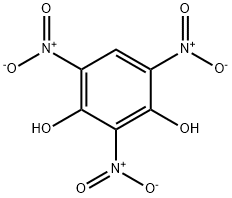스티프닉 산 C화학적 특성, 용도, 생산
화학적 성질
Yellow crystals; astringent taste. An initiating
explosive. Forms addition
compounds with many hydrocarbons; soluble in
alcohol and ether; slightly soluble in water.
용도
2,4,6-Trinitroresorcinol has been used in the manufacture of explosives.
일반 설명
A yellowish, crystalline solid. May explode under exposure to heat or fire. Primary hazard is blast of an instantaneous explosion, not flying projectiles or fragments. Used as a priming agent. Very sensitive to heat. Water is added to lessen the explosion hazard.
반응 프로필
Aromatic nitro compounds, such as TRINITRORESORCINOL, range from slight to strong oxidizing agents. If mixed with reducing agents, including hydrides, sulfides and nitrides, they may begin a vigorous reaction that culminates in a detonation. The aromatic nitro compounds may explode in the presence of a base such as sodium hydroxide or potassium hydroxide even in the presence of water or organic solvents. The explosive tendencies of aromatic nitro compounds are increased by the presence of multiple nitro groups.
위험도
Severe explosion risk when heated.
건강위험
Fire may produce irritating, corrosive and/or toxic gases.
화재위험
MAY EXPLODE AND THROW FRAGMENTS 1600 meters (1 MILE) OR MORE IF FIRE REACHES CARGO.
Safety Profile
Very explosive. Upon decomposition it emits toxic fumes of NOx. See also NITRO COMPOUNDS of AROMATIC HYDROCARBONS and EXPLOSIVES, HIGH.
Purification Methods
Crystallise the phenol from ethyl acetate or water containing HCl [EXPLODES violently on rapid heating.] Its solubility in H 2O is 0.7% at 20o and 3% at 100o. It forms addition compounds with aromatic hydrocarbons, e.g. naphthalene (m 168o), anthracene (m 180o), phenanthrene (m 142o), fluorene (m 134o) and retene (m 141o). [Beilstein 6 H 830, 6 III 4354, 6 IV 5699.]
스티프닉 산 준비 용품 및 원자재
원자재
준비 용품








